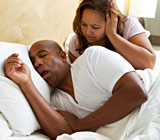 Getting enough sleep is necessary for good health. We all know how energetic we feel when we are sleeping well at night. Yet, many of us do not feel rested, even after seven or eight hours of sleep. Let’s answer some common questions about snoring and sleep apnea, problems that are often called sleep related breathing disorders (SRBD).
Getting enough sleep is necessary for good health. We all know how energetic we feel when we are sleeping well at night. Yet, many of us do not feel rested, even after seven or eight hours of sleep. Let’s answer some common questions about snoring and sleep apnea, problems that are often called sleep related breathing disorders (SRBD).
What is the purpose of sleep?
Scientists know we need sleep, at a particularly deep level, to be rested, but they are not sure why we need sleep. Sleep may have evolved as a way to conserve energy in the body, to conserve food supplies, or to reduce our risk during darkness. Sleep appears to give the brain a chance to store and organize its information and the body a chance to recuperate. Sleep studies have shown that in order to get the full benefits of sleep we need to sleep long and deeply enough to enter into a series of sleep cycles including Rapid Eye Movement (REM) and Non-Rapid Eye Movement (NREM) sleep.
What kinds of problems get in the way of the type of sleep we need?
There are eight main categories of sleep disorders, but the ones affecting the largest numbers of people are insomnia, SRBD, and Circadian Rhythm Sleep Disorders. SRBDs include snoring and Obstructive Sleep Apnea (OSA), which is a serious health problem.
How do I know if I have OSA or another SRBD?
Often, your bed-partner will tell you that you snore. Chronic loud snoring is an indicator of OSA. To make a diagnosis your physician must take a thorough sleep and medical history. The diagnosis may then be confirmed by a study in a sleep lab.
What causes sleep apnea or OSA?
Snoring and OSA happen when your tongue and other soft tissues in the back of your throat collapse backwards and block airflow through your upper airway or windpipe. You may briefly awaken as many as 50 times per night because of these breathing lapses. These brief awakenings, called micro-arousals, keep you from reaching the deep stage of sleep your body needs.
What are the treatments for sleep apnea?
Treatments include CPAP therapy, in which patients wear a mask while sleeping. The mask pushes air through the airway, keeping it open. In Oral Appliance Therapy (OAT) patients wear a device that moves the lower jaw forward, allowing more room for air to move down the airway. Oral surgical procedures and orthodontic approaches also have the goal of moving the tongue away from the throat. These are all treatments that can be carried out by a dentist who has training and experience in treatment of sleep disorders.
Contact us today to schedule an appointment to discuss your questions about sleep disorders and their treatments. You can also learn more by reading the Dear Doctor magazine articles “Sleep Disorders and Dentistry” and “Sleep Apnea Frequently Asked Questions.”



